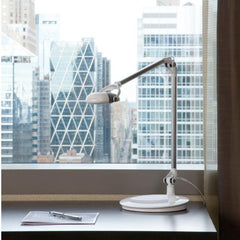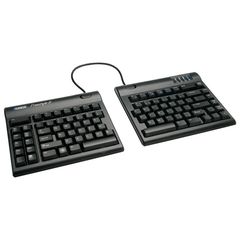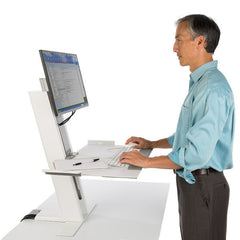According to the Bureau of Labor Statistics, the average American works 8.8 hours every day. Whether you earn your daily keep in a traditional office or at home, it goes without saying then that the arrangement of your office space has a profound impact on your health.
Some common risk factors associated with an unergonomic office include poor posture, increased eye strain, back and neck pain, to carpal tunnel syndrome. (view more on our syndromes page)
When you consider the laundry list of potential health hazards stemming from a poorly set up office space, a sense of urgency should kick in to address the issue immediately. Optimizing your office space for ergonomics may sound like a daunting task, but the truth is, many ergonomic changes don’t even require you to purchase any additional equipment, and merely involve rearranging, adjusting, and working with your existing monitor, keyboard, desk and chair. Once you’ve made those basic adjustments, you can then go on to making the appropriate investments for more ergonomic hardware.
In this article we look at a few creative and traditional ways to make your office space more ergonomic, which in practical terms leads to a safer, healthier, and more productive YOU.
Ensure Proper Lighting
Every kind of office work requires good lighting for productivity, but also for comfort. You want to ensure lighting doesn’t have potentially damaging ultraviolet (UV) radiation. Good lighting means adequate illumination so that documents can be seen clearly. Complaints from poor lighting can include blurred vision, dry eyes, eyestrain and headaches. Poor lighting doesn’t only affect the ocular system but can also contribute to aching shoulders and a stiff neck. Natural light is always best, but if you don’t get sufficient light from sunlight and windows, ensure you have sufficient lighting from the right type of light which limits glare. A combination of different light sources can be adapted to the office’s light requirements.
Address the Glare
Using a computer with its glare and flicker can take its toll on your health, especially if you’re staring at it 8 hours a day. Cutting down glare can be a mere case of positioning your screen to prevent direct light falling onto it. Experts always suggest that your monitor be 500 to 700mm from your face and that it be directly in front of you. The top edge should be more or less at eye level. Anti-Glare filters can also be a great help when the glare on your screen is just too much.
Take More than Lunch Breaks
Remember to take rest- and exercise breaks from your computer every hour. Stand up and move around. Go outside and breathe in some fresh air. There are also many stretching and gentle exercises that you can do in your break and which will help to relieve muscle fatigue. Keep an infographic on your desk of the types of stretches you can do so as to prevent injuries and pain and make work more enjoyable.
Get an Ergonomic Keyboard
If you spend the best part of your day at the computer, a quality keyboard and mouse becomes a necessity. Ergonomic keyboards have been designed to fit the natural position from which one types and these keyboards will remove the strain on your fingers and wrists.
Consider a Standing Desk
A standing desk allows you to take turns sitting and standing. To help your body out of a slouching position and to give it a break from sitting, why not arrange a modern, adjustable standing desk into your workspace? Back pain is a common complaint of office workers who sit all day. Studies show that there is an improvement in lower back- and neck pain after using a sit-stand desk for several weeks.
Jon Muller at ErgonomicTrends.com is an ergonomic enthusiast and expert, and explains to us the different options you have when it comes to standing while working:
“When people think of standing desks, they usually have in their heads an expensive table with a mechanical lift that moves the table up and down. That’s certainly an option if you need a large working area, but for many people, a desk riser or stand will more than suffice. These are peripherals that boosts your computer hardware such as the monitor, keyboard etc so they’re at eye level when you stand. Many desk stands offer a large enough working space to mimic a regular desk, with gas springs to easily adjust the height with a push of the button. To me this is a best option for anyone that wants the full benefits of alternating between standing and sitting when working, without having to replace the existing desk with a standing one.”
Make Sure Your Office Chair is Supporting You
For a productive workstation, you need a good ergonomic chair which will allow you to maintain the correct posture and which will support your back, hips, legs and arms. The arm rests should be comfortable and adjustable. The entire chair should be adjustable – raising and lowering the seat and adjusting the back tilt. The chair should have a stable base and allow you to swivel with ease. The material needs to be of a breathable fabric to allow for ventilation and the seat height needs to be such that you can place your feet flat on the floor while sitting.
Conclusion
Optimizing your office space for ergonomics doesn’t require a major overhaul, A little bit of repurposing can improve your work space. Get past the notion that an office is essentially for productivity and nothing else.
A quality workspace makes for happier workers and if you feel well you perform at a higher level. An ergonomic workspace plays such an important role in ensuring that your tasks aren’t a monotonous grind. Health is an equilibrium and an ergonomic workspace ensures your body and mind are in balance and that work becomes a soothing experience.
Read the full article from TG Daily here





